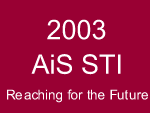
Adventures in SuperComputing - Summer Teacher Institute
Dreamweaver Fundamentals
Implementation Phase
Now is the time to put it all together and see what learning has taken place. This is the final exam, the implementation of an end product that will be the focus for pulling all the material, ideas, and applications together. This should be done in a public forum to develop skills in communication and presentation. The learners should have some presentation options, and these choices should be given at the beginning of the assignment. However, the development of a Web site with specific criteria (number of links, images, content sources, etc.) can be a highly effective framework for this program of study.
By defining the final product expectations from the beginning, the instructor provides a context for students to utilize the computer technology and Internet resources into a cohesive project. From an instructional sense, the tools are overlapping and fluid. One new tool will be needed at this time, and that is the file transfer protocol (FTP [PC] or Fetch [Mac]). This allows the user to put their files (text, images, video, and sound) into a folder on a Web server for access by the outside world.
For the instructor, this new knowledge can be added incrementally at the beginning of each lesson within this phase. It is also a time to use peer instruction and cooperative groupings, as the knowledge students gained in applied software skills can be valuable to the progress and learning in the classroom. Regular times to share and collaborate should be woven into the classroom time, along with extended periods to plan, research, develop, and refine the work. This is also the point where the classroom appears most constructivist, in that learners are constantly putting their new knowledge to use and building on their previous premises. The classroom should be active, filled with discussion and group interaction, far from your basic drill-and-kill approach.
Remember is is the Site Manager that you will use for tracking local and remote site files. You will set up a local site that is housed in a local root folder, and then use the Site manager to connect to the server in order to put your files up on the Internet. Dreamweaver has an FTP function that will allow you to move files from your local to the remote (PUT) and from the server back to the local folders on your machine (GET).
See Macromedia Dreamweaver Reference Text - Chapter 19
